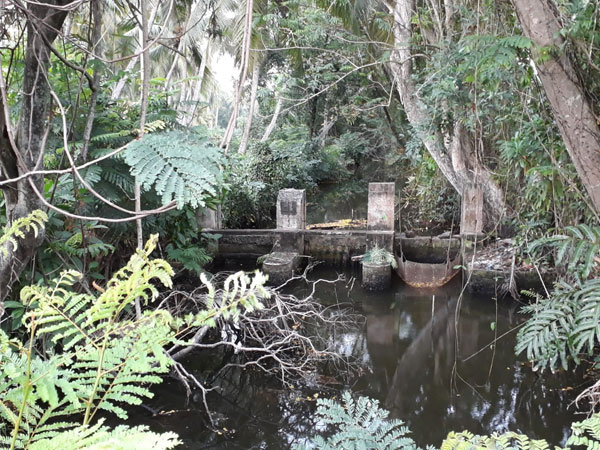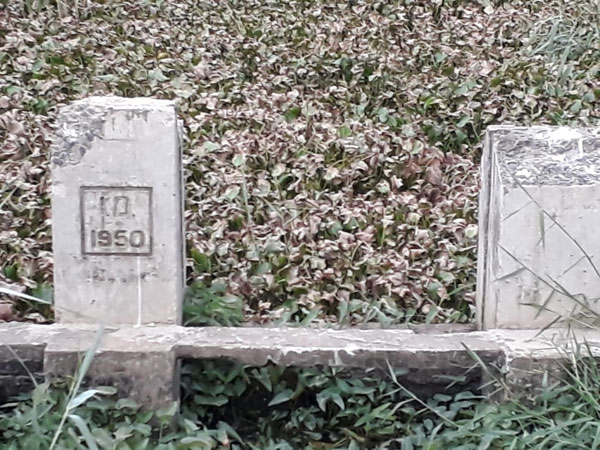News
Official apathy over M’rajawela flooding
“I am standing in ankle-deep flood water as we speak, this has been happening for 20 years.”
Sixty-year-old company secretary A.H.W. Mahinda has been a resident of ‘Nilsirigama’ scheme in Muthurajawela for the past 21 years. And twice a year without fail, his house gets flooded when the monsoon arrives. The drains and irrigation channels are blocked.
The Muthurajawela wetlands are naturally flood-absorbing and an invaluable asset to people all the way from Kelaniya to Ja-ela. However, illegal filling up, the dumping of waste into canals, and the under-utilisation of a 70-year-old irrigation system worsens the flooding.

The year ‘1950’ is engraved on the anicut, but residents claim that it had never worked
Mahinda’s house remains inundated from the rains in August. Sand and chalk he had purchased earlier this year to plaster a side of his house lay wet and unused because even the road outside his home is flooded.
“We didn’t get any aid from the government,” he said, noting that Rev Fr. Jayantha of St. Nicholas’ Church Bopititya had fed the community regardless of which faith people belonged to. He noted that the floods are usually so severe that Bopitiya Junction goes under as well.
Local representatives, however, were clueless.
Local government member Ruban Jayamanne insisted that floods were not an issue for the people in the area he represented.
Wattala Divisional Secretary P.C. P.G. Raajika claimed that there was no flooding pattern and that the weather was a factor.
She said flooding was an issue faced mainly by those living on encroached marshy lands. “Unauthorised constructions go under water because they’re built in the wrong places without the proper approvals from the authorities,” she noted, adding that there was little they could do in such circumstances.
But area residents refute this claim.
Pubudugama resident, Kumudini Jayatilaka, said that areas that the government itself bestowed on the people are also going under. She said the drainage systems in her area are so badly managed that any heavy rainfall floods her home up to knee high.
The dumping of waste, especially in Kerawalapitiya, and the canals contributing to the irrigation system in Muthurajawela, and the government handing out unsustainably built houses as part of political propaganda had been devastating to the ecosystem. However, the stoic irrigation system consisting of multiple canals, anicuts and anicut doors, has also never been used.
“They haven’t functioned in years and I don’t really know why,” said Irrigation Department divisional engineer S.A.C.S. Suraweera. The canals in the system belonged to the irrigation department.
He claimed that the system is debilitated and when questioned as to why renovations had not been done in the past 20 years, he once again claimed that he did not know and that some of the anicuts fell under the purview of the Sri Lanka Land Development Corporation. The Sunday Times attempted to contact SLLDC officials, but did not receive a response.
The year ‘1950’ is engraved on the anicut, but Mr. Suraweera claims that it had never worked.
He added that the Irrigation Department had begun projects to study the system in the area some years ago, but these had been abandoned for undisclosed reasons.
He also reiterated that none of the “old villages” became flooded and that those affected are the “encroached lands” from 1994. This claim is heavily refuted by residents. As of now, 3,000 families are suffering from flooding.
Environmentalist and Muthurajawela resident Anil Jayamaha explained the geographic layout of the irrigation system.
“We experience both monsoons of the year in April and August. This lasts for about three months every year. First, the Attanagalu canal fills up when rains begin there. This flows into Dalugan canal in Ja-ela and comes that way. There are two villages on either side of this canal that flows into the lagoon — Bopitiya and Diyalthuna. The Ja-ela bund on the Diyalthuna side is 2-2.5 feet lower, while the Muthurajawela bund is 2-2.5 feet higher.
“Past this, there is an anicut known as ‘Thunmodora’, meaning three anicuts. From there the Olanda canal, along the highway, begins. It goes towards Peliyagoda and Kerawalapitya where they dump garbage. When the anicut doors are opened, the Olanda canal water flows into Muthurajawela. When the canal water in Olanda rises by about 1-1.5 feet, local authorities need to bring in this water for the Maha season. When this preparation is done and the flood gates are opened, there is another anicut that needs to be opened to bring the water in and spreads across Muthurajawela – this is known as flushing.
“It’s called flushing because the soil in Muthurajawela has high salinity because the lagoon is nearby. So when the rainwater comes, it cleans the soil of the extreme salt levels, thus making it more suitable for agriculture. This flushed water goes to the lagoon, the Hamilton Canal and the Parana Olanda canal through 10 more anicuts.
“This is where the local authorities need to coordinate and reduce the water gradually.”
He claims that this would allow authorities to also prepare for the Kelani River overflows.
The best way to say that you found the home of your dreams is by finding it on Hitad.lk. We have listings for apartments for sale or rent in Sri Lanka, no matter what locale you're looking for! Whether you live in Colombo, Galle, Kandy, Matara, Jaffna and more - we've got them all!

